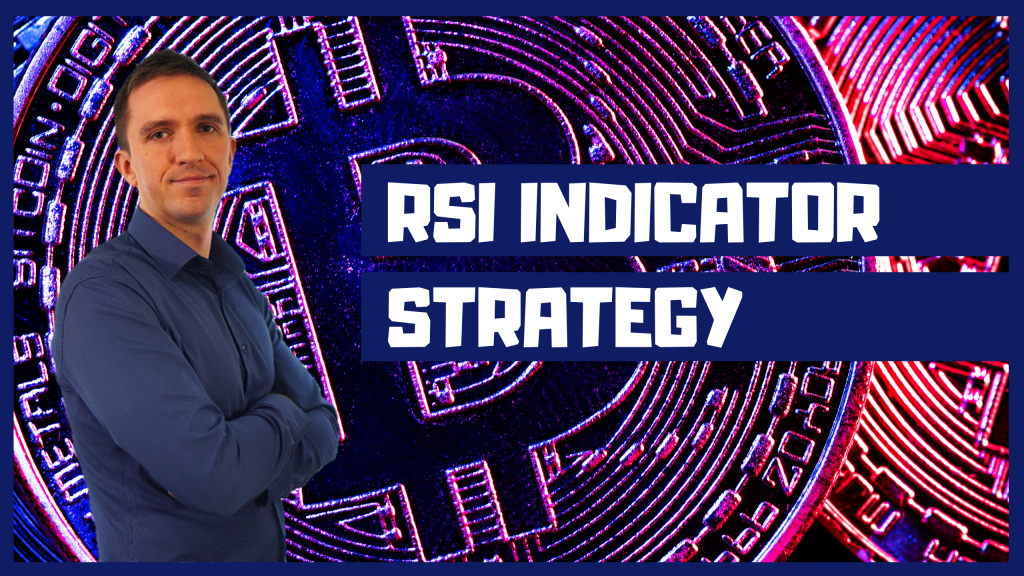RSI indicator strategy
Hello dear traders, I’m excited to start with the 1st strategy which I call the RSI Indicator strategy for Bitcoin M15. Why? Because it is for the Bitcoin and I traded on M15 chart, and the entry rule is based just on the RSI Indicator.
Honestly, with time I saw that it is not really necessary to make your strategies too complicated or to use complicated strategies. Many people think that if they use complicated strategies with many rules, indicators, and drawings on the chart, it is a more profitable strategy.
Not necessarily and you will see that sometimes the simpler strategy is the better, and especially for manual trading, because you are following just a few Indicators.
This Bitcoin strategy is part of the Top 5 Strategies (+EAs) for Cryptocurrency Algorithmic Trading course which you can find in the Algorithmic trading section.
At first, I will start explaining this RSI Indicator strategy by adding the RSI Indicator, which is in the group of the Oscillators. It is the Relative Strength Index, or it is known as the RSI.

When do we buy and sell with this RSI Indicator strategy?
Now the default period is 14, but what I will be using is a period of 28.

And for levels, I will just change 70 and 30. So on the top I will have 70 add below I will have 30. I will click on OK.

So you can see how it will look below the chart. Here it is.

We have 2 lines. That is the 70 and below we have 30. The blue line is the RSI. I’m not going into details about how these Indicators are calculated because you really don’t need to know that. I studied in London, but with time I saw that what’s most important is to learn how to use the indicators and not how they are calculated. You don’t really need to know that.
So straight to the point, what is our entry to buy? This is when the RSI crosses the level line upwards, the 70 line, and we sell when the RSI crosses the 30 line downwards.
The confirmation with the RSI Indicator strategy
So the entry is when the RSI crosses the 30 signal line downwards. This is one we want to sell. And we Buy when the RSI crosses the 70 level upwards.
Let’s take an example. I will just put 1 vertical line. We have the cross on the opening of the next bar. We wait for the next bar to open. When the next one opens, we have the confirmation to sell it.
I will put as well 1 horizontal line so we can see exactly where is the entry. It is 10 692.

I say the next bar opening because the RSI, like most of the indicators, is a repeating indicator. This means that if we have the cross at this bar and then the price reverses, later we might not see the cross.
The RSI will just change and we will not see the cross. We usually wait for 1 bar for confirmation that it’s an actual cross of the RSI. This applies to all of the Indicators and all the strategies that we use. The entry with this RSI Indicator strategy happens on the next bar after the bar is opened and after we see there is an actual cross.
The Money Flow Index
So this is our entry with the RSI Indicator strategy. At this point we sell. What is our exit rule? We use the Money Flow Index. I will go to Indicators and I will insert the Money Flow Index, which is in volumes,

and then I will use period of 44 instead of 14.
As well, I will use levels of 24 and 76, and I click on OK.

You will see the indicator just below the RSI. It’s a very similar indicator but it’s calculated differently.

In this case, you can see that the MFI or the Money Flow Index crosses the level line later, which is actually our exit condition.

We enter at that moment when the RSI crosses the level line downward, we sell. Then when the MFI crosses the level line downwards, we take the profit, and again I will put 1 vertical line so we can see where exactly it is.

Here, and on the opening of the next bar, we have the confirmation and we close the trade. We Sell at $10 692 and then we take the profit at $10 590 which is about $102 or $100 and something. Pretty much, this is the trading. We enter because of 1 trading rule.
The Stop Loss in this RSI Indicator strategy
We exit because of a different trading rule. Also, we have a Stop Loss and a Take Profit. The Stop Loss is a level at which the trade will close automatically. It is easy to set. So if I want to sell, I would go to Trading, and I would go to New Order.

You can see that I have the Sell button and I have the Buy button, and I have the option to put a Stop Loss and a Take Profit. In this case, the Stop Loss is $240.

It will be $240 above the entry price. Let me use the calculator, so you will see how I calculate it.
The entry price is $10 692 plus $240, that would be $10 932.

I take another horizontal line, $10 932. I’m not going to do it very precisely.

I just want to show you how I calculate it. Then what we have is the Take Profit.
We have the entry price, one more time, at $10 692 because we are selling. The Take Profit is $170. That would be $10 522. I take another horizontal line, $10 522. Let me make the horizontal line green for the Take Profit.

The Take Profit in this RSI Indicator strategy
I will summarise what we have. We have the entry because the RSI crosses the level line downwards, and on the opening of the next bar we sell.
On the moment we sell, what we need to do is to place the Stop Loss and the Take Profit. This means that if the price goes towards the Stop Loss, we will be on a loss, but it will close automatically. We will take a loss, but we will protect our capital. We are not taking a huge loss.
Then if the price goes downwards towards the Take Profit, you are not in front of the screen and it reaches the Take Profit, it will close the trade automatically and you will have your profit.
If you are in front of the screen, you can use the exit condition when the MFI or the Money Flow Index crosses the level line downwards, which happened at this moment. So the Stop Loss and the Take Profit are there to protect the trade.
It is very important to protect the capital
If anything happens, let’s say you are not in front of the computer or if you have to go out, maybe your internet connection is disturbed, you lose electricity or whatever, and you cannot manage the trade with the exit condition, then the Stop Loss and the Take Profit will close the trade. Especially with this strategy, it happens quite often that the Take Profit or the Stop Loss are hit before the exit condition.
So, for example, just a little bit later, we have a new entry. The RSI crosses the level line downwards again.

On the opening of the next bar, we must enter another trade. We should sell again. This is the level of $10 478.

Let’s place the Stop Loss and the Take Profit. I will do it very quickly again with the calculator. $10 478 minus Take Profit of $170, we have $10 308.

So our Take Profit will be lower at the level of $10 308. I’m trying to put it just in the right place. If you want to put it exactly where it must be, you can just go to horizontal line properties,

and from Parameters, you can enter it, $10 308.

How do we sell without having the asset?
We enter at that moment because the RSI crosses the level line downward and then the Take Profit is hit perfectly with this candlestick, and we will take the profit. The Money Flow Index is below the level line.
There is no other cross downwards. It goes upwards. So with this strategy, when I trade it, I see more frequently that the Take Profit is hit or the Stop Loss. But sometimes, well, the Money Flow Index plays the role of an exit rule. I really hope that you understand this strategy.
It is very simple: 2 Indicators, 1 entry, 1 exit, Stop Loss and Take Profit. And I started with this example for a sell because, with cryptocurrency trading, we can sell even if we haven’t bought it previously. This is one of the most frequently asked questions that I get from the students, how we sell if we don’t have the asset.
Well, this is the balance that we have in the account. No matter whether it is Demo or real money, it’s your balance. With this balance, you can buy and you can sell it.
CFD trading works great for this RSI Indicator strategy
I am sure that in this case, again, we will hit the Take Profit, but I’m not going to make the lecture any longer. When we buy, we can close the trade at a more expensive price. And when we sell, we sell and we close the trade at a lower price and we benefit from the difference.
We benefit these USD as difference. In this case, the Take Profit is $170 if you trade a complete lot or a complete Bitcoin. This is called CFD Trading or we trade on the value of the asset. CFD stands for contract for difference.

Every time we sell, we make a contract with the broker that if we close the trade at a lower price, we will benefit from the difference. And, of course, if we close it on the loss, we will be losing from our balance. And I mentioned the lot.
In trading, when we execute the trades, we call this 1 trading lot. And for the Bitcoin, this is 1 Bitcoin. So if you are trading 1 lot, basically, you are buying 1 Bitcoin and because we have leverage, we can buy more from what we have in the account.
I will attach a PDF to describe the RSI Indicator strategy
I don’t need to have $10 700 in my account to Buy 1 Bitcoin or to Sell 1 Bitcoin. It’s because we use leverage. It depends on what type of account you open with your broker. How much is the leverage you selected to use? Different brokers offer different options.
You can check out this with the broker. Basically, that’s cryptocurrency trading. We can sell, we can close the trade at a lower price, and benefit from the difference. So stay with me until the end of the course. You will see how the other strategies work and you will see as well how I trade this strategy and the rest 4 with Expert Advisors.
One last thing here for each of the strategies, I will attach a PDF which will describe the strategy very briefly. For example, this is the RSI strategy.

It works on the Bitcoin for M15 timeframe. We have the Stop Loss and the Take Profit. I have written it as $240 because it depends on how many digits your broker uses.
For instance, the Pepperstone broker uses 2 digits after the decimal. Some are 3 and people get confused. How many points is that? How many pips is that? But here, we have just Stop Loss of $240 and Take Profit of 170.
We need to constantly modify the RSI Indicator strategy
Something important to mention is that when you buy the course, you will see different parameters inside the PDF because while the market changes, we need to modify the strategies. Don’t expect that you get 1 Expert Advisor or 1 strategy, and you do profits constantly with it without changing anything or working on the strategy.
However, that’s my work and I monitor these strategies and these Expert Advisors, and if I need to make a change, I will change it. Or if there is no change, I just put under no changes so you know that the strategy is the same as it was before.
When you take the course, it will be in a future moment. Obviously, from the time I’m creating the lecture, you just need to look at the PDF attached to this lecture, and the same for the other strategies and use the parameters that are inside the PDF. Obviously, those will be different from the examples I showed in this lecture.
Thank you for reading. I will see you right in the next video.



